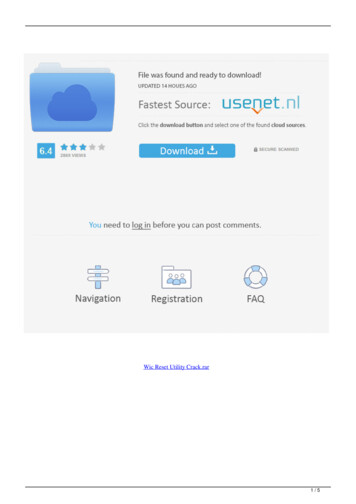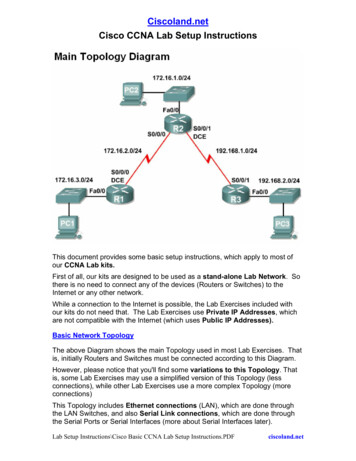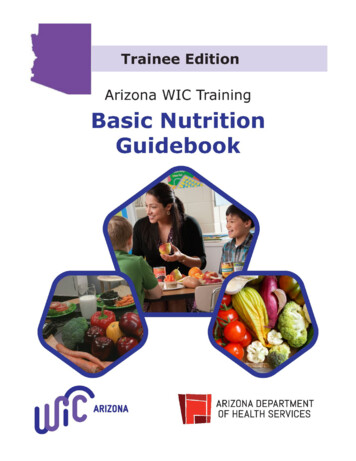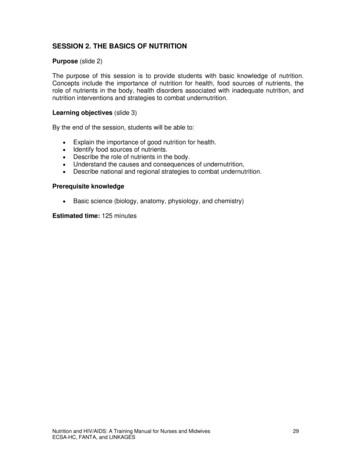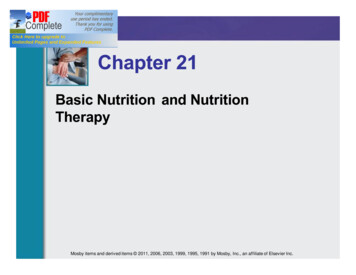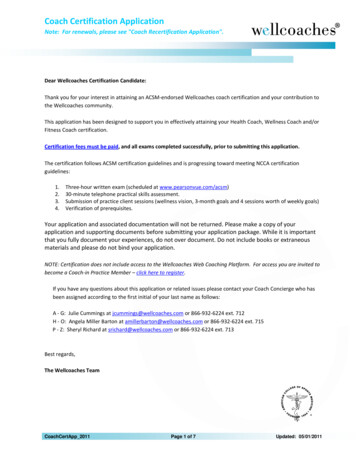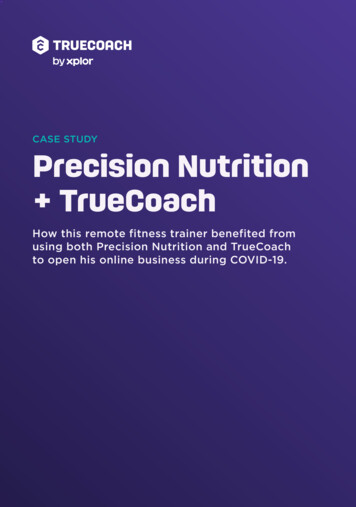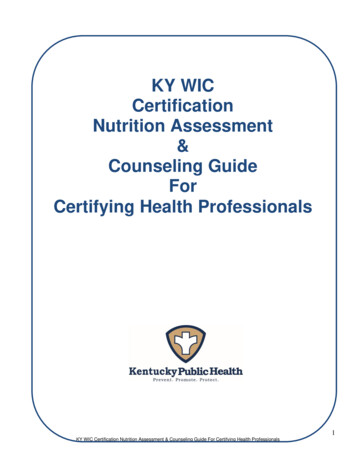
Transcription
KY WICCertificationNutrition Assessment&Counseling GuideForCertifying Health Professionals1KY WIC Certification Nutrition Assessment & Counseling Guide For Certifying Health Professionals
Purpose of KY WIC Certification Nutrition Assessment &Counseling GuideForCertifying Health ProfessionalsThis is to be used as a supplement to the Kentucky WIC and Nutrition Manual, Clinical Nutrition andBreastfeeding Support Section that contains policies regarding WIC Certification Criteria, RequiredNutrition Education, Policies on Food Package Assignment, Issuance of Breast Pumps, etc. Thisguide is designed to provide the Certifying Health Professional additional guidance and tools inperforming nutrition assessment including dietary assessment and providing participant centerednutrition education.The WIC Program provides, without cost to the recipient, specific nutritious foods and nutritioneducation to low income and nutritionally at risk pregnant, breastfeeding and postpartum women andto infants and children.The goals of WIC are to: Improve the outcome of high risk pregnancies Decrease the incidence of anemia and poor growth patterns Improve the dietary habits of its recipients through healthy foods and nutrition education Refer for other health services as appropriateA Certifying Health Professional shall determine nutritional risk eligibility and certify persons for theProgram Applicants/participants must have at least one nutritional risk to be eligible. A height/length,weight, hematocrit/hemoglobin, and health, lifestyle and dietary information shall be obtained for allapplicants. Refer to Medical Data Requirements for Certification and WIC Certification Criteria in theClinical Nutrition and Breastfeeding Support Section of the WIC and Nutrition Manual.2KY WIC Certification Nutrition Assessment & Counseling Guide For Certifying Health Professionals
WIC CERTIFICATION NUTRITION ASSESSMENTThe WIC Certification Criteria for Women, Infants and Children are found in the Clinic ManagementSystem (CMS) and on the following WIC Certification Forms. The WIC certification and assessmentcriteria and nutrition risk assessment policies are consistent with the following: USDA, FNS, WIC Nutrition RISK Criteria, WIC Policy Memorandum 2011-5; May 2011. USDA, FNS, Value Enhanced Nutrition Assessment (VENA) - WIC Nutrition Assessment Policy, WICPolicy Memorandum 2006-5; March 2006. USDA, FNS, Nutrition Risk Criteria, WIC Policy Memorandum 98-9; June 1998. USDA, FNS, Transmittal of Revised and Corrected Nutrition Risk Criteria, May 2017.NUTRITION ASSESSMENTNutrition assessment serves as the foundation on which other nutrition services are planned and provided.This includes: Food package assignment; Referrals; Nutrition education and counseling; and Breastfeeding promotion and support.VALUE ENHANCED NUTRITION EDUATION (VENA)Value Enhanced Nutrition Education (VENA) begins with the nutrition assessment. Beyond determining WICeligibility, nutrition assessment is utilized to enhance the interaction between the Certifying Health Professionaland WIC participant, link the collected health and diet information to the delivery of participant centeredrelevant nutrition education, referrals and food package tailoring.Nutrition assessment and participant centered nutrition education and counseling includes open endedquestions to determine what concerns or questions the participant has in regards to her nutrition, child’snutrition, and/or infant’s nutrition.Individualized nutrition education counseling is then provided to address the identified questions, concerns andgoals.See the Clinical Nutrition and Breastfeeding Promotion Section for policies regarding WIC Certificationassessment and counseling and copies of the WIC-75.3KY WIC Certification Nutrition Assessment & Counseling Guide For Certifying Health Professionals
WIC NUTRITION SERVICES PROCESSThis graphic from Vena, A Guide to the Art and Science of WIC Nutrition Assessment illustrate thecomplete process of WIC participant centered WIC assessment and follow-up.Complete WIC Nutrition AssessmentThe WIC program uses a standardized process of collecting nutrition assessment information for all participants.This will help assure that all applicants are assessed in a consistent manner. A comprehensive nutritionassessment is needed to identify nutrition risks, assign an appropriate food package, and guide WIC participant-centered nutrition services after the assessment has been completed. A comprehensive nutrition assessmentwill allow the Certifying Health Professional to individualize nutrition services provided to each participant.The following components must be used in completing a nutrition assessment: Observe participant and review participants’ anthropometric, biochemical, clinical/medical, dietary andeconomic/family data. Ask pertinent questions to clarify, probe for additional information, or follow-up on informationparticipant or parent/caretaker has written or verbalized. Listen to and affirm the participant or parent/caretaker. Use critical thinking to determine:o nutrition risk and food packageo possible contributing factors to the nutrition risko participant’s or parent/caretaker’s understanding of the health or nutrition risks and readiness tochange behavioro participant-centered approach to inform participant or parent/caretaker of the identified nutritionrisk(s) and/or barriers to positive health outcomes Document the findings in automated or paper WIC-75.4KY WIC Certification Nutrition Assessment & Counseling Guide For Certifying Health Professionals
PLAN OF CAREPlan of care must include: Individualized goal should be clearly stated and documentedo Be related to the participant’s identified nutritional risk(s) and the participant/family’snutrition related interest(s); ando Be actionable with a measurable timeframe for completion Documenation of the progress toward that goal at follow-up visits Appropriate referrals with follow up documentation regarding appointments kept/serviceprovided at follow-up nutrition visit.TIPS ON GOAL SETTINGMost participants or parent/caretakers have something they would like to change or learn more about theirchild’s health (a goal or goals). The Certifying Health Professional (CHP) can help facilitate this changethrough effective counseling. Participants are the best judge of what will work for their family.Goal setting needs to be participant-driven. The CHP’s goal is to help participants to succeed at theirgoals.Work with participants to set realistic, measurable goals. Suggesting small, reachable goals – takingbaby steps – is a way to help your participants change behaviors and feel successful with those goals.Meet a participant or parent/caretaker where they are. Any movement toward change has the potentialto provide this participant with a better health outcome. Certifying Health Professionals are to help theparticipant/caretaker where they are in the change process.Discuss and problem-solve participant or parent/caretaker’s concerns and barriers to achieving thegoal(s).To help participants set goals, possible questions that could be asked include: “You have mentioned that you are concerned about , what is it that you want to changeabout that?” “We talked a lot about , how would you like for things to be different?” “Most times it is easier to take things one step at a time. What do you think is the first step?” "If things worked out exactly as you would like, what would be different?" "I know that it seems like an uphill battle to , and now that we've discussed some optionsthat have worked for other participants, do you think any would work for you? If so, which one?" "Would you like to talk about some ideas that have worked for other moms and see if any work foryou?"5KY WIC Certification Nutrition Assessment & Counseling Guide For Certifying Health Professionals
STEPS IN A NUTRITION ASSESSMENT1. Establish rapport. (Positive Connection with Participants) Welcome participant/caretaker and introduce yourself Demonstrate caring attitude and offer help when appropriate Use open ended questions, participant centered questions and 3-Step counseling whenappropriate.2. Visually observe the participant, when present. For example, observe: Physical appearance (e.g. if appears pale, listless, obvious tooth decay, etc.) Parent-child interaction What parent is feeding the child in the office? If bottle is present: What is in the bottle? Is older child sucking on a bottle in the office? etc.3. Look at the anthropometric data obtained and review the growth chart.Use critical thinking skills to ask: Are there concerns - underweight, overweight, a change in growth patterns? Does the weight/height today seem to match what you see when you look at the participant? Does the data make sense? If not, reweigh and/or re-measure the participant. Were there problems or unusual circumstances in weighing or measuring?o If so, this should be documented. For example: “child was very fussy and moving duringmeasuring” or “child has a cast on right arm so unable to weigh.”o Unknown is to be checked if a child has a cast and you are not able to get a correctweight.The CMS system will assign a risk code based on anthropometric data that meets nutrition riskcriteria. If there appears to be an error, review input information. If the error remains, make a notein the notes section of the WIC- 75 as well as draw a single line through any risk codes assignedthat are not appropriate.4. Look at hemoglobin/hematocrit data.Is it within normal limits or is there a concern?If not within the normal range, use critical thinking to ask: Is data questionable and needs to be re-checked? (was the finger dry, was there an air bubblein sample?) What additional questions do you need to ask regarding health history and diet? Has there been a significant change since the last measurement (if applicable) or is thereperhaps an error in measurement? Has the child been sick? Is an immediate referral necessary?5. Ask questions about health or prenatal history. Is there a medical referral or formula request? Is information up-to-date? Is information complete?6. Consider the participant/caretaker responses to medical and nutrition questions.Use critical thinking to ask: What are the participant or parent/caretaker’s concerns? What additional questions need to be asked?6KY WIC Certification Nutrition Assessment & Counseling Guide For Certifying Health Professionals
What probing questions should be asked that may help to explain what might cause or contributeto the anthropometric or hematological data seen?Are there any medical or dental issues identified?Should a referral be given?What amounts and types of foods are eaten and what is frequency of eating? For example,if the parent says the child drinks “juice” at meals, ask how much juice the child drinks in a dayand the kind of “juice” the child drinks.Is there a lack of understanding/knowledge?Are there cultural or family patterns that impact the participant’s choices?Who else lives in the household that makes decisions about the foods purchased, prepared, oroffered to the participant?How do these issues impact the participant’s health or nutritional status?7. Before you suggest a specific food package for this participant, consider such things as medicalconditions, allergies, intolerances, refusal to consume specific foods, alternative ways to preparefoods, and environmental factor. Refer to Food Package Assignment, Clinical Nutrition and Breastfeeding Support Section of WICand Nutrition Manual.8. Inform participant or parent/caretaker in an affirming, participant centered manner of the riskfactors and barriers to positive health outcomes that have been identified. Give participantopportunity to have input as to which issues to discuss further and what goal(s) they are willing toconsider.9. Close on a positive note. Provide any recommended referrals. Express appreciation for their time. Let them know you look forward to hearing how things go.7KY WIC Certification Nutrition Assessment & Counseling Guide For Certifying Health Professionals
PARTICIPANT CENTERED NUTRITION EDUATION ASSESSMENT AND COUNSELINGTECHINIQUETHREE STEP COUNSELINGNutrition assessment and participant centered nutrition education and counseling includes open endedquestions to determine what concerns or questions the participant has in regards to her nutrition, child’snutrition, and/or infant’s nutrition. Beyond determining WIC eligibility, nutrition assessment is utilized toenhance the interaction between the Certifying Health Professional and WIC participant, link the collectedhealth and diet information to the delivery of participant centered relevant nutrition education, referrals andfood package tailoring. Individualized nutrition education counseling is then provided to address the identifiedquestions, concerns and goals.Three Step Counseling is a technique that is useful in implementing participant centered nutrition assessmentand education.The Three Steps:1. Ask open ended questions.2. Affirm Participant3. EducateSTEP 1: ASKING OPENING ENDED QUESTIONSBegin your questions with the words, “What,” “How,” or “Tell me ” to ask things in an open way. With closedquestions, mothers often feel interrogated or they feel they must come up with the “right” answer, whether theybelieve it or not. Open questions help build rapport, which helps mothers feel confident and safe sharing theirconcerns.Example of open ended questions: “What have you heard about breastfeeding?” “How are you planning to feed your baby?” “Tell me about your child’s eating habits”A “probe” is a follow-up question, usually asked in an open-ended way. Probes help you get a bigger picture ofwhat the mother means by the things she says. There are many different types of probes that can be used tolearn more. The United States Department of Agriculture’s Loving Support through Breastfeeding, A JourneyTogether Curriculum offers this information regarding “Probing” questions.What it isHow it worksExtending ProbeAsks the mother to tell you more.Clarifying ProbeHelps you understand what the mothermeans by what she has told you. Itoften uses the words “do you mean?”“When you say , do you mean?”Reflecting ProbeRepeats the mother’s words back to herso she can hear what she said. It oftenbegins with the words, “So you’resaying ”Examples Redirecting ProbeHelps you change the subject or steerthe conversation in a differentdirection. This works best when themother’s concerns are acknowledgedbefore changing the subject. What else have you heard about that?How did you feel when he said that?Tell me more.When you say it’s too hard, do you mean itwill be too hard to learn to breastfeed?Are you afraid breastfeeding will beembarrassing to you or to someone whomight see you?So you’re saying you don’t think you canbreastfeed?You think the baby’s father will feel leftout, and that worries you?It sounds like it’s important to you tobreastfeed.I can see you’re concerned about yourfinances, and we’re going to get you somenames of people who can help. Other thanthat concern, what else worries you?What other concerns do you have?Adapted from USDA’s Loving Support through Breastfeeding, A Journey Together Curriculum.8KY WIC Certification Nutrition Assessment & Counseling Guide For Certifying Health Professionals
STEP 2: AFFIRMAffirmation is a short, simple statement that lets a participant know her feelings are okay. Affirmationacknowledges not what she says, but her feelings behind what she is saying. Many mothers feel uneasy aftersharing their concerns, and worry that the health professional may think they are silly. It can put a mother at easeto know she is not alone and that you recognize the feelings that are important to her. Once her feelings arevalidated, a mother is more likely to hear the information you will share with her.Five Way to Affirm1. Agree with her. “You’re right. Breastfeeding can be time consuming at first.” “I felt that way, too”2. Assure her she’s not alone. “Many moms have felt that way.” “That’s a pretty common reaction.” “Many women go through a period like that after the baby is born”3. Read between the lines to discover what she is worried about. “I can see that keeping your baby happy is very important to you.”4. Shine the spotlight on what she is doing well. “It’s great you are breastfeeding! A lot of moms would have given up.”5. Show her she’s a good mother. “It’s obvious how much you love your baby.”STEP 3: EDUCATEOnce you have asked open-ended questions, used probes to identify the mother’s true concerns, and affirmedthe mother’s feelings, you are ready to begin educating the mother. Education is in the form of simple bits ofinformation that help address the mother’s concerns. It works best when it focuses on options and solutions.When providing the nutrition education, carefully target information to the concern uncovered in step one,provide information in small simple bites and allow the participant to participate in the learning process and insetting goals for changes.The United States Department of Agriculture’s Loving Support Through Breastfeeding, A Journey TogetherCurriculum offers this information regarding educating in the Three Step Counseling technique.Education tipsWhy it’s importantWays to use itKeep it simple.Complicated instructions makebreastfeeding sound difficult orunmanageable.Adults tend to “tune out” people who aresharing information that does notinterest them. Mothers will rememberinformation they find relevant to them.Focus on 2-3 simple ways to handle herconcerns. Think “tweet” to keep it shortand simple.Once a mother has identified her concern,give her a couple of options that addressthe concern she has identified, not yourown “laundry list” of information youwant her to know.Record the mother’s concern in yournotes, and review it in your next call orvisit. Or, send a brochure that addressesthat concern.Consider offering 2-3 options that workedfor you or for other moms. You can say,“Here are a couple of things that workedfor other moms. You can pick whateveryou think might work best for you.”Target her concerns.Reinforce your message.Adults are more likely to rememberinformation they’ve heard more thanonce.Give options.When adults receive options, they feelthey are more in control of their choices,and can select the options they believewill work best for them. Offeringoptions also helps them feel theirconcerns can be overcome since there ismore than one solution.Moms may like to have resources torefer to later, in case they forget thingsyou shared.Share resources.Share WIC pamphlets, simplebreastfeeding books, or videos to reinforceyour information. You can also shareinformation about classes or mother’sgroups she might like to attend.9KY WIC Certification Nutrition Assessment & Counseling Guide For Certifying Health Professionals
ASSESSING AND TARGETING YOUR NUTRITION MESSAGE BASED ON THE PARTICIPANTSREADINESS FOR CHANGEWhen counseling WIC mothers, remember that not all women are at the same place in their “readiness” to hearyour information. You will want to change the way you talk with a mom depending on where she is in her decisionmaking process. The 3-Step Counseling skills will help you identify where a mother is in that process and howyou can best reach her.The United States Department of Agriculture’s Loving Support Through Breastfeeding, A Journey TogetherCurriculum, Module 4, How to Talk to Moms about Breastfeeding offers this information regarding educating inthe Three Step Counseling technique based on readiness.Not ReadyA mother who is not ready may need more time to think about breastfeeding. She may be feelingoverwhelmed, or have had a previous negative experience. Your role is to keep the conversation going andhelp her not feel judged. Your power tool is affirmation.3-Step power toolsHow they might soundOpen-ended Questions“Tell me some things you have been thinking about”Affirmation“It sounds like you’ve been giving this a lot of thought. That’s great!”“That’s a common reaction from other moms.”Encourage her to: Think about breastfeeding Be open Learn about breastfeeding to make an informed choiceEducationUnsureA mother who is unsure has some awareness of the importance of breastfeeding, but may be weighing prosand cons. Avoid giving her too much information.3-Step power toolsHow they might soundOpen-ended Questions“Tell me some things you’ve been thinking about.”“Who might be around to support you?”“I can tell you’re giving this a lot of thought.”“It sounds like being a good mom is very important to you.”Encourage her to: Explore options that might work for her. Take baby steps by learning more.AffirmationEducationReadyWhen a mother is ready, she has weighed the pros and cons and feels she can work breastfeeding into herlife. She is open to your ideas and suggestions.3-Step power toolsHow they might soundOpen-ended Questions“What are some things you feel will make it a good experience for you?”“Who will support you with breastfeeding?”“It’s great you are planning to breastfeed!’Encourage her to: Talk with the people close to her about breastfeeding. Attend a breastfeeding class to be well prepared.AffirmationEducation10KY WIC Certification Nutrition Assessment & Counseling Guide For Certifying Health Professionals
COUNSELING IN DIFFICULT SITUATIONSThe United States Department of Agriculture’s Loving Support Through Breastfeeding, A Journey TogetherCurriculum, Module 4, How to Talk to Moms about Breastfeeding offers this information regarding educating indifficult situations. Be sensitive to the mother’s situation and honor her wishes. Realize that you only see partof the snapshot of her life, and seek to understand rather than judge.Not interested Show understanding and affirm her decision to do what she feels will be best. Tell her WIC wants to help her make an informed choice and will support her. Ask if you can check on her periodically to see how her pregnancy is progressing. This builds trust andallows her to change her mind later if she chooses.Rude Be sensitive to what may be going on in her life. Affirm her and avoid the temptation to react negatively to her rudeness.Shy Ask open-ended questions that cannot be answered with one or two words.Let her know that WIC peer counselors are moms just like her.Affirm where she is and let her know it is okay to be unsure about things right now.Previous sexual abuse Let her know that WIC can put her in touch with people she can talk with if she desires. Affirm the mother, who may be feeling overwhelmed and scared. Let her know that for some mothers, breastfeeding is a way to bring about healing.Overly dependent on you Affirm the mom’s willingness to come to you with questions. Point her to resources to learn more so that many of her questions can be answered in other ways. Remind her that you have many other WIC participants to counsel and she might need additionalassistance from the WIC Designated Breastfeeding Expert.Received misinformation Rather than contradicting the information she received, support the important relationships in themother’s life. Share new information the mother might not be aware of to help her make an informed decision. Encourage her to bring family members with her to the breastfeeding class. Report any misinformation incidents.Three Step Counseling Reference:United States Department of Agriculture’s Loving Support through Breastfeeding, A Journey TogetherCurriculum, Module 4, How to Talk to Moms about Breastfeeding.11KY WIC Certification Nutrition Assessment & Counseling Guide For Certifying Health Professionals
ASSESSING NUTRITION AND DIET&DOCUMUNTING RISK ON THE WIC-75The WIC-75 is utilized to access and document the certification subjective data, objective measurements,assessment, and plan. When completing the paper or automated WIC-75, the Certifying Health Professionalwill be documenting definitive measurements and responses. The goal of the Value Enhanced NutritionAssessment, which is participant centered, is to have a conversation with the participant/family about theircurrent concerns, choices, and goals. With questions that are closed or simply require a “yes” or “no”response, mothers often feel interrogated or required to come up with the “right” answer, whether they believeit or not. Open and conversationally participant centered questions help build rapport, which helps mothersfeel confident and safe sharing their concerns.Example of Closed and Participant Centered Questions:To assess for the risk code 411.9 Inappropriate Infant Feeding Practice -Feeding an infant leftoverbreastmilk or formula from an earlier feeding:Closed Question: “Do you feed your baby leftover breastmilk or formula from an earlier feeding?”In the closed version of the question, the participant will respond with a “Yes” or “No” and may feel judged orsecond guess herself. The Certifying Health Professional is not building rapport or trust with the mother.Mom may leave WIC clinic feeling confused or less confident in her ability to care for her infant.Participant Centered: “If your baby doesn’t finish a bottle, what do you do with the left over breastmilk orformula?”In the participant centered question, she has an opportunity to share how she handles left over breastmilk orformula and has the opportunity to expand on any issues or concerns she may be having with left overbreastmilk or formula. This then leads to the certifying health professional to assess a concern and allow for anutrition education to address her concerns. There is an opportunity for rapport and to build trust with themom. Mom may leave feeling more confident and empowered to care for her infant. The Certifying HealthProfessional completes the nutrition visit feeling satisfied with the positive interaction.On the following pages are sample participant questions a Certify Health Professional may utilize whencompleting nutrition assessment/WIC Certification for each participant category. These are sample questions,and not an exhaustive list of all potential questions or follow up probing questions.12KY WIC Certification Nutrition Assessment & Counseling Guide For Certifying Health Professionals
Sample Participant Centered Questions for Completing WIC-75Pregnant: Tell me about any concerns or problems you have had with this pregnancy or any previouspregnancies. What concerns do you have about your eating habits? How do you feel you are eating during this pregnancy? How do you feel about your weight gain during this pregnancy/previous pregnancy? What concerns or questions do you have about physical activity during pregnancy? Please tell me about any major surgeries, trauma or burns you have had. What have you heard about breastfeeding? What are your plans for feeding your baby? What topics or concerns would you like to discuss today? Please tell me about the foods you usually eat to help us tailor your food package (may probebased on food groups-grains, meat/protein, dairy, fruits and vegetables, may probe based onmeal/snack). Has a doctor asked you to eat a special diet or special foods, if yes please describe. What medications vitamins, or herbs are you taking? What are your plans for returning to work or school after the baby is born? How is that advice working for you? Are there any concerns with your refrigerator or stove working at home? Have you had any problems with your stove or refrigerator in the past 6 months? What does your household use for drinking water? In the past month, have there been days when you did not have enough food or money to buyfood? Is this your first pregnancy? Tell me about your previous pregnancies. Have you had any discomforts commonly seen in pregnancy (heartburn, nausea, vomiting, andconstipation)? How many times a day do you usually eat including meals and snacks? Are there any foods you are avoiding? How often do you eat food and snacks away from home such as from fast food, vendingmachines, and restaurants? What type of milk do you drink/does your family drink? Are you having cravings or have you eaten anything unusual such as ashes, clay, chalk, bakingsoda, ice, etc.? Are you having any difficulty taking your prenatal vitamin daily? What have you heard about kangaroo care/skin-to-skin care? Have you discussed with your employer/school your need to pump when you return? Does anyone in your home smoke?13KY WIC Certification Nutrition Assessment & Counseling Guide For Certifying Health Professionals
Sample Participant Centered Questions for Completing WIC-75Breastfeeding Woman: Tell me about how things are going since the baby is home. Tell me about how your family and friends are supporting breastfeeding now that you are home. Tell me about any concerns or problems you had with this pregnancy. Tell me about any concerns or problems you had during delivery. Any concerns for your baby? How do you feel about breastfeeding now that you are home from the hospital? How do you feel you are eating since delivery? How do you feel about your weight since you had your baby? Do you have a weight loss goal since delivery? How was your delivery experience? Were you able to place baby in kangaroo care skin-to-skin care right after delivery? Since having your baby, do you have any health concerns for yourself? Or your baby? Have you had any problems with your teeth or gums since you had your baby? Are you breastfeeding or pumping milk for your baby? How is it going? Are you using birth control? What type? Do you need more information on birth control andbreastfeeding? Please tell me about any major surgeries including C-section, trauma or burns you have had. Have you seen your doctor since you had you
Beyond determining WIC eligibility, nutrition assessment is utilized to enhance the interaction between the Certifying Health Professional and WIC participant, link the collected health and diet information to the delivery of partici
